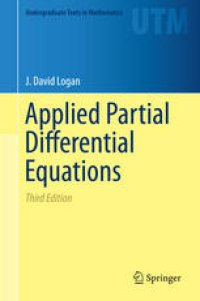
Ebook: Applied Partial Differential Equations
Author: J. David Logan (auth.)
- Genre: Mathematics // Differential Equations
- Tags: Partial Differential Equations, Mathematical Methods in Physics, Community & Population Ecology
- Series: Undergraduate Texts in Mathematics
- Year: 2015
- Publisher: Springer International Publishing
- Edition: 3
- Language: English
- pdf
This textbook is for the standard, one-semester, junior-senior course that often goes by the title "Elementary Partial Differential Equations" or "Boundary Value Problems". The audience consists of students in mathematics, engineering, and the sciences. The topics include derivations of some of the standard models of mathematical physics and methods for solving those equations on unbounded and bounded domains, and applications of PDE's to biology. The text differs from other texts in its brevity; yet it provides coverage of the main topics usually studied in the standard course, as well as an introduction to using computer algebra packages to solve and understand partial differential equations.
For the 3rd edition the section on numerical methods has been considerably expanded to reflect their central role in PDE's. A treatment of the finite element method has been included and the code for numerical calculations is now written for MATLAB. Nonetheless the brevity of the text has been maintained. To further aid the reader in mastering the material and using the book, the clarity of the exercises has been improved, more routine exercises have been included, and the entire text has been visually reformatted to improve readability.
This text presents the standard material usually covered in a one-semester, undergraduate course on boundary value problems and PDEs. Emphasis is placed on motivation, concepts, methods, and interpretation, rather than on formal theory. The concise treatment of the subject is maintained in this third edition covering all the major ideas: the wave equation, the diffusion equation, the Laplace equation, and the advection equation on bounded and unbounded domains. Methods include eigenfunction expansions, integral transforms, and characteristics. In this third edition, text remains intimately tied to applications in heat transfer, wave motion, biological systems, and a variety other topics in pure and applied science. The text offers flexibility to instructors who, for example, may wish to insert topics from biology or numerical methods at any time in the course.
The exposition is presented in a friendly, easy-to-read, style, with mathematical ideas motivated from physical problems. Many exercises and worked examples have been added to this edition. Prerequisites include calculus and ordinary differential equations. A student who reads this book and works many of the exercises will have a sound knowledge for a second course in partial differential equations or for courses in advanced engineering and science. Two additional chapters include short introductions to applications of PDEs in biology and a new chapter to the computation of solutions. A brief appendix reviews techniques from ordinary differential equations.
From the reviews of the second edition:
“This second edition of the short undergraduate text provides a fist course in PDE aimed at students in mathematics, engineering and the sciences. The material is standard … Strong emphasis is put on modeling and applications throughout; the main text is supplied with many examples and exercises.”
—R. Steinbauer, Monatshefte für Mathematik, Vol. 150 (4), 2007
“This is a unique book in the sense that it provides a coverage of the main topics of the subject in a concise style which is accessible to science and engineering students. … Reading this book and solving the problems, the students will have a solid base for a course in partial differential equations … .”
—Tibor Krisztin, Acta Scientiarum Mathematicarum, Vol. 74, 2008